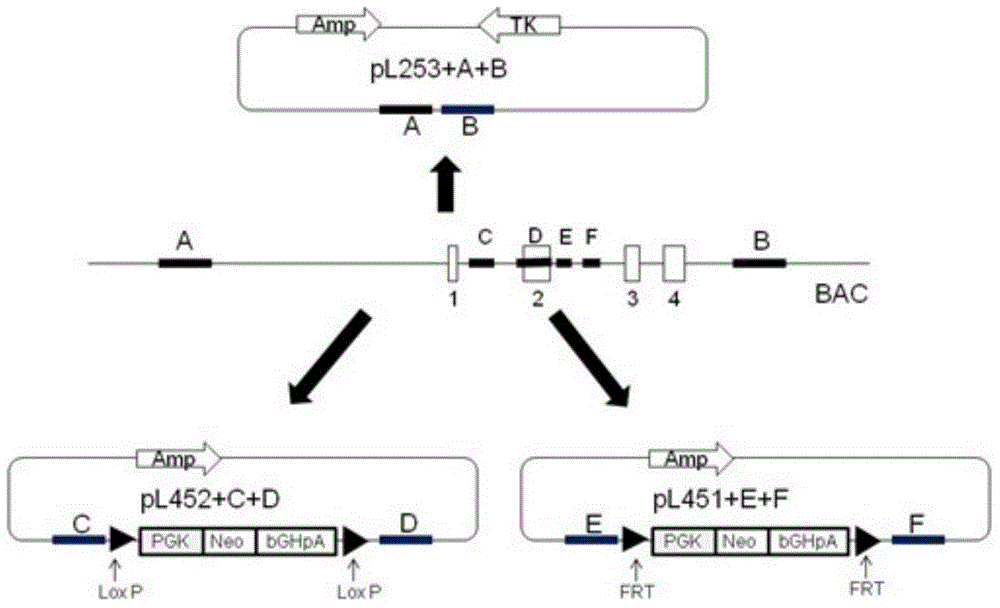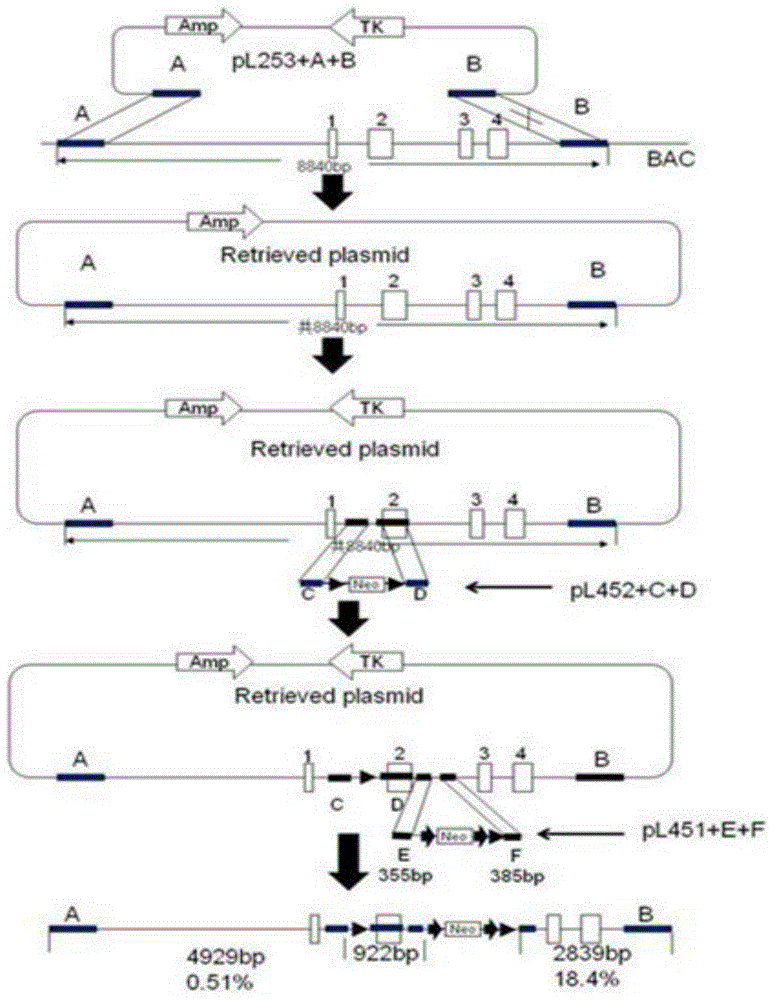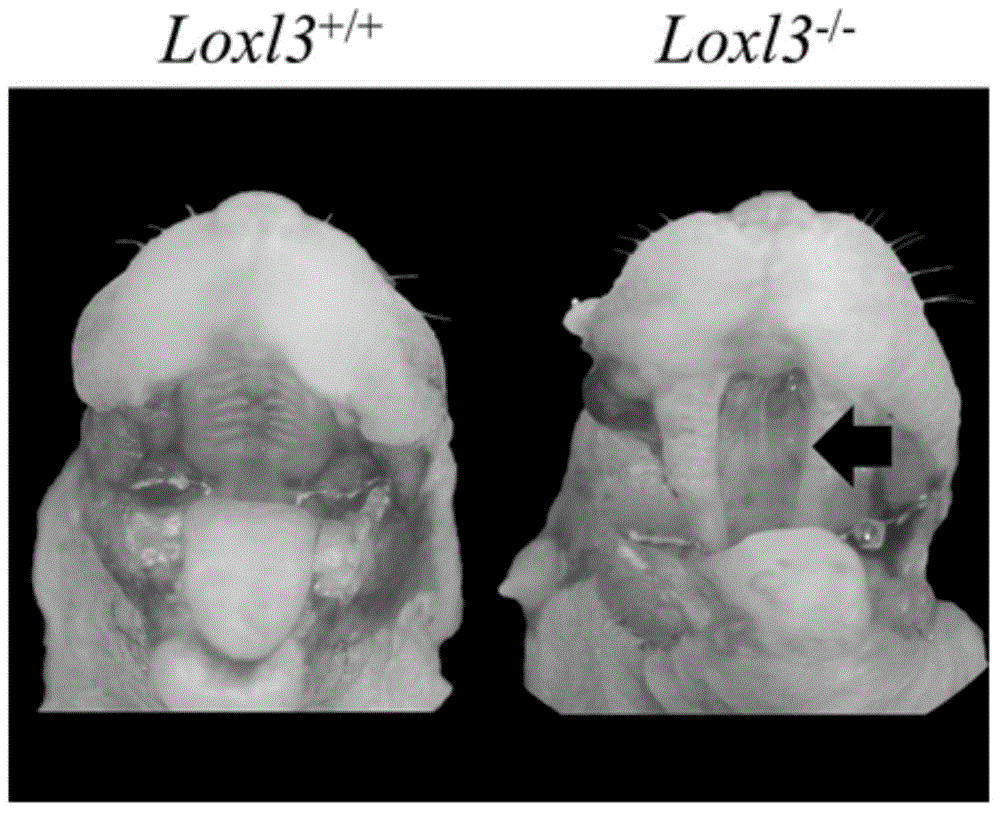Method for conditional knockout of Lox13 gene of mouse and application
A gene knockout, conditional technology, applied in the field of genetic engineering
- Summary
- Abstract
- Description
- Claims
- Application Information
AI Technical Summary
Problems solved by technology
Method used
Image
Examples
Embodiment 1
[0046] The construction of embodiment 1Loxl3 conditional gene knockout vector
[0047] The design of the vector is to knock out the second exon (containing the promoter sequence) of the LOXL3 gene, so as to realize the inactivation of the entire gene. Firstly, six homologous recombination fragments (A, B, C, D, E and F) were amplified from BAC, and connected into pL253, pL452 and pL451 ( figure 1 ), through one-step retrieval and two-step homologous recombination, two loxP sites and Neo marker genes (two FRT sites on both sides) were introduced on both sides of the second exon of the LOXL3 gene to construct a LOXL3 conditional gene knockout Remove vector plasmid ( figure 2 ); then linearly transfected ES cells with the vector plasmid, and screened positive ES clones for homologous recombination; finally, injected ES clones into C57BL / 6 mouse blastocysts by microinjection technology, and obtained LOXL3 conditional gene knockout by PCR screening mice.
[0048] 1. Extraction...
Embodiment 2
[0205] Transfection and screening of embodiment 2Loxl3 conditional gene knockout vector
[0206] 1. Large-scale extraction of Loxl3 conditional gene knockout vector plasmid
[0207] (1) Inoculate the preserved strain DH5α containing the vector plasmid (Beijing Quanshijin Biotechnology Co., Ltd.) on ampicillin (50 μg / ml) and kana (50 μg / ml) resistant solid medium plates, and culture at 37 ° C 12h, pick a single colony and inoculate it into 5ml LB liquid medium, culture at 37°C, 200rpm shaking for 12-16h;
[0208] (2) Take 1ml of bacterial liquid and transfer it to 500ml LB liquid medium, shake and culture at 37°C and 200rpm for 12-16h;
[0209] (3) Centrifuge at 6000g for 10min at 4°C, discard the supernatant and collect the bacteria;
[0210] (4) Use QIAGEN's large extraction kit for extraction, add 4ml of reagent P1 to the collected bacteria, and suspend it;
[0211] (5) Add 4ml of reagent P2 to the tube, gently turn it upside down 4-6 times, and keep it at room temperatur...
Embodiment 3
[0253] Example 3 Using microinjection technology to make floxed mice that can be used for conditional gene knockout
[0254] The ES cells that were screened and identified correctly were injected into the blastocysts of C57BL / 6 mice through microinjection technology (see the mouse embryo operation guide), and the injected blastocysts were transferred to the uterus of pseudopregnant mother mice for implantation, giving birth to embedded embryos. Zygomatic mice, chimeric mice were mated with C57BL / 6 mice to produce brown and black offspring mice. The tails of the brown mice were cut off to extract DNA, and the positive mice were screened by the long PCR amplification described above, which were floxed mice with loxl3 conditional gene knockout. The mouse tail DNA extraction steps are as follows:
[0255] The DNA extraction steps are as follows:
[0256] (1) Cut the 0.3-0.5cm long mouse tail and put it into an EP tube. After shredding, rinse with normal saline or PBS, and centr...
PUM
 Login to View More
Login to View More Abstract
Description
Claims
Application Information
 Login to View More
Login to View More - R&D
- Intellectual Property
- Life Sciences
- Materials
- Tech Scout
- Unparalleled Data Quality
- Higher Quality Content
- 60% Fewer Hallucinations
Browse by: Latest US Patents, China's latest patents, Technical Efficacy Thesaurus, Application Domain, Technology Topic, Popular Technical Reports.
© 2025 PatSnap. All rights reserved.Legal|Privacy policy|Modern Slavery Act Transparency Statement|Sitemap|About US| Contact US: help@patsnap.com



